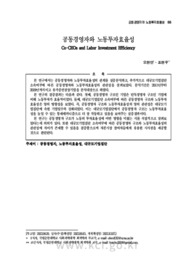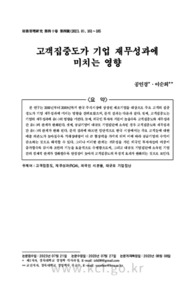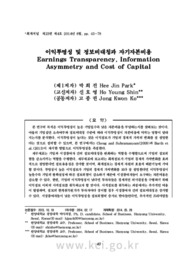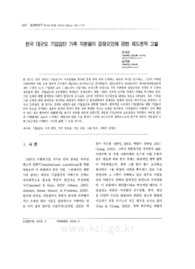

PARTNER
검증된 파트너 제휴사 자료
대규모기업집단 소속기업의 투자효율성 (The Investment Efficiency of Firms Belonging to Large Business Conglomerates)
44 페이지
최초등록일 2025.06.08
최종저작일
2014.06

-
미리보기
서지정보
· 발행기관 : 한국회계학회
· 수록지 정보 : 회계학연구 / 39권 / 3호 / 91 ~ 134페이지
· 저자명 : 임상균, 이문영, 황인이
초록
본 연구에서는 대규모기업집단 소속기업들의 투자효율성에 대해 분석하였다. 과거의 국내외 연구들은 대규모기업집단 소속기업들이 비효율적이고 많은 문제점을 가지고 있다고 보고한 경우가 많았다. 그러나 최근 수행된 다수의 연구들은 오히려 대규모기업집단 소속기업들이 기타 기업들에 비해 우수하다는 증거들을 다수 제시하고 있다. 본 연구에서 대규모기업집단 소속기업들을 기타 기업들과 비교한 결과 투자효율성이 높다는 증거를 발견하였다. 첫째, 대규모기업집단 소속기업들은 과소투자가 이루어질 가능성이 높은 상황에서 다른 기업들 보다 많은 투자를 하고 있었으며, 과대투자가 이루어질 가능성이 높은 상황에서는 다른 기업들보다 적은 투자를 수행하고 있었다. 둘째, 추가적으로 대규모기업집단 소속기업들만을 대상으로 분석해 본 결과, 지배주주의 현금흐름 수취권리가 높은 기업이나 기업집단의 중핵기업이 과대투자가능성이 높은 상황에서 그렇지 않은 기업들보다 투자가 적어, 높은 투자효율성을 보였다. 그러나 지배주주의 소유지배괴리 수준, 피라미드식 혹은 순환출자 형태의 소유구조는 투자효율성과 유의한 관계를 보이지 않았다. 마지막으로, 대규모기업집단 소속기업들은 사외이사 비율이 높은 기업이 과대투자가능성이 높을 때 상대적으로 투자가 적어 투자효율성이 높았다. 그 밖에 사외이사의 전문성 혹은 활동성은 투자효율성과 유의한 관계가 없었다. 이런 발견들은 기업집단과 지배구조의 역할에 대해 여러 중요한 시사점들을 제시해 주고 있다.영어초록
This paper investigates two issues related to investment efficiency: (1) How affiliation with family-controlled large business conglomerates in Korea (Chaebol) influences investment efficiency, and (2) among firms belonging to Chaebol groups, how the governance mechanisms at the conglomerate-level and firm-level influence investment efficiency.
There has been a prolonged controversy on the role of business conglomerates. Family- controlled large business conglomerates are found in many countries, including Asian and European countries. La Porta et al. (1999) report that these firms are mostly controlled by the concentrated ownership of families.
Many prior studies criticize that firms belonging to business conglomerates engage in non-value maximizing activities to increase the influence of controlling shareholders. For example, in some cases, firms engage in tunneling activities to transfer wealth from a firm to another firm over which controlling shareholders have more cash flow rights. In other cases, several firms in the conglomerate help another firm that is in financial difficulties. This behavior is called propping. Controlling shareholders of business conglomerates build large empires and try to increase the assets under their control. For this purpose, controlling shareholders engage in tunneling or propping, which results in the sacrifice of the wealth of minority shareholders (Betrand et al. 2002; Cheung et al. 2006; Kim 2008; Jian and Wong 2010; Kwon et al. 2012). For these reasons, firms belonging to business conglomerates may make inefficient investments that result in inferior firm performance. Several studies using Korean data confirm this argument (Choi and Cowing 1999; Chang 2003; Joh 2003: Kim 2011). Studies in accounting also document evidence that confirms this argument. For example, Fan and Wong (2003) find that as the ownership divergence between cash flow rights and voting rights of business conglomerates increases, the earnings response coefficient decreases. In contrast to these criticisms of the business conglomerate, several recent studies have started to report on the beneficial roles of business conglomerates. Using Indian data, Siegel and Choudhury (2012) report that firms in business conglomerates engage in more long-term business strategy and research and development activities. Additionally, Khanna and Palepu (2000) report that business conglomerates more efficiently use internal cash and thus lower information asymmetry. These findings are consistent with those of Korean studies. Lee et al. (2010) document that Korean business conglomerates changed their behaviors after the 1997 financial crisis. Thus, they exhibit higher profitability and less volatility than other firms. Their leverage ratio has also dropped, suggesting that they are less likely to use external debt financing. Similarly, Kim (2012) reports that firms belonging to business conglomerates grow more rapidly, have a higher level of investment with higher profitability. Park and Jung (2011) argue that business conglomerates create synergy effect that help the survival and restructuring process.
In summary, the findings of recent studies generally suggest that business conglomerates are not likely to engage in inefficient investments. In addition, prior studies on the issue mostly use naive and descriptive methods. They simply compare the level of investments and future (ex post) profitability with benchmark firms. Although this analysis is suggestive, it does not control for other factors that may be related to the investment level. Using the sophisticated method developed by Biddle et al. (2009), this study investigates the investment efficiency issue related to business conglomerates. Biddle et al.’s (2009) method classifies firms into two subsamples: the situation in which over-investment is likely to occur and the opposite situation in which under-investment is likely to occur.
The samples used in this study are Korean listed firms (excluding firms in the banking and finance industries) over the period from 2001 to 2009. Data on business conglomerates are collected from the website of the Korean Fair Trade Commission. The final sample size is 6,217 firm-year observations from 1,177 firms. Among them, 803 observations belong to firm in family-controlled business conglomerates.
Our empirical results are summarized as follows. First, consistent with the findings in most of the recent studies, we find that firms belonging to business conglomerates engage in less over-investment (under-investment) than other firms when they are in situations in which over-investment (under-investment) is likely to occur. Second, among conglomerate-level governance mechanisms, we find that firms with high cash flow rights and firms that play a central role in the conglomerate, respectively, engage in less over-investment than other firms when over-investment is likely to occur. Ownership divergence, firms’ position in pyramid-type structures, and circular shareholdings are not related to the investment efficiency. Third, among firm-level governance structures, we find that firms with a high ratio of independent outside directors are likely to engage in less over-investment than other firms when over- investment is likely to occur. In contrast, the ratio of grey directors, board members with other directorships, existence of accounting experts among outside board members, and ratio of board meeting attendance by outside directors are not significantly related to investment efficiency.
These findings, combined together, provide valuable implications to regulators, firms, and other interested parties. We hope future studies investigate related issues further to clarify the role of business conglomerates and their governance mechanisms.참고자료
· 없음태그
-
자주묻는질문의 답변을 확인해 주세요

꼭 알아주세요
-
자료의 정보 및 내용의 진실성에 대하여 해피캠퍼스는 보증하지 않으며, 해당 정보 및 게시물 저작권과 기타 법적 책임은 자료 등록자에게 있습니다.
자료 및 게시물 내용의 불법적 이용, 무단 전재∙배포는 금지되어 있습니다.
저작권침해, 명예훼손 등 분쟁 요소 발견 시 고객센터의 저작권침해 신고센터를 이용해 주시기 바랍니다. -
해피캠퍼스는 구매자와 판매자 모두가 만족하는 서비스가 되도록 노력하고 있으며, 아래의 4가지 자료환불 조건을 꼭 확인해주시기 바랍니다.
파일오류 중복자료 저작권 없음 설명과 실제 내용 불일치 파일의 다운로드가 제대로 되지 않거나 파일형식에 맞는 프로그램으로 정상 작동하지 않는 경우 다른 자료와 70% 이상 내용이 일치하는 경우 (중복임을 확인할 수 있는 근거 필요함) 인터넷의 다른 사이트, 연구기관, 학교, 서적 등의 자료를 도용한 경우 자료의 설명과 실제 자료의 내용이 일치하지 않는 경우
“회계학연구”의 다른 논문도 확인해 보세요!
-
재무적 여력이 판매관리비의 하방경직성에 미치는 영향 41 페이지
본 연구에서는 기업의 재무적 여력(financial slack)이 판매관리비 행태에 미치는 영향을 분석하였다. 재무적 여력은 고정비용으로 인한 재무적 위험을 낮추어 매출감소시에도 수익성 높은 기업자원을 유보하는 경향을 강화할 것이므로 이에 따라 판매관리비의 하방경직성이 강화될 것이다. 또한, 영업현금흐름의 변동성이 큰 기업은 투자재원의 제약으로 인해 자원을.. -
회계이익과 과세소득의 차이가 회사채 신용등급에 미치는 효과에 대한 재검토 및 새로운 증거 55 페이지
본 연구는 회계이익과 과세소득의 차이(BTD)가 회사채 신용등급(RATING)에 미치는 영향을 분석하였다. 본 연구는 이전 연구들의 주장과 같이 경영자의 기회주의적 이익조정으로 보고이익이 상향조정되면 회계이익이 과세소득보다 커질 수 있어 이익의 질은 낮아질 것으로 보고, 이런 경우 신용평가기관이 신용등급을 더 낮출 것으로 기대했다. 실증분석기간은 2001년.. -
재량적 발생액과 부채조달비용 간의 관계에 대한 실증적 증거 52 페이지
본 논문의 목적은 재량적 발생액과 부채조달비용 간에 어떤 관계가 있는지를 규명하는데 있다. 선행연구들은 경영자가 기회주의적 이익조정 수단의 하나로 재량적 발생액(DA) 수준을 증가시키면 채권투자자들은 대출이자율을 증가시킬 것으로 예상하였다. 그러나 이러한 주장은 채권투자자들이 기업의 DA 수준에 대하여 효과적인 탐지가 가능할 것이라는 전제가 있어야 한다. .. -
산업 내 경쟁정도와 실제이익조정 - 기업지배구조와의 상호작용을 중심으로 - 34 페이지
본 연구는 상품시장 차원에서의 경쟁 정도 및 기업의 시장지배력이 경영자의 회계선택의 일환으로 여겨지는 실제 이익조정(real earnings management) 행태에 어떤 영향을 미치는지를 규명하고자 다양한 측면에서 실증분석을 수행하였다. 분석 결과를 요약하면 다음과 같다. 첫째, 독점도가 높은 산업에 속한(산업 내 경쟁정도가 낮은 산업에 속한) 기업일.. -
파트너연고 감사인변경과 회계정보 가치관련성의 관계 43 페이지
선행연구(Blouin et al. 2007; Vermeer et al. 2008 등)에서는 감사담당 파트너의 소속 회계법인(감사인) 이동을 따른 고객회사의 감사인변경을 “파트너연고 감사인변경(auditor changes following partner familiarity)”이라고 표현하였다. 국제적 대형회계법인의 급격한 변동이 있었던 2000년대 초, 국..
찾으시던 자료가 아닌가요?
지금 보는 자료와 연관되어 있어요!
문서 초안을 생성해주는 EasyAI








